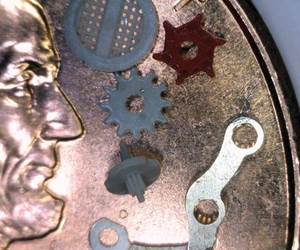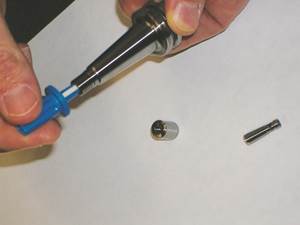Predictive Index: Learn How to Make Better Hiring Decisions and Develop
In November, PMPA began partnering with PI Worldwide to help solve the problem of finding and retaining skilled machinists.
In November, PMPA began partnering with PI Worldwide to help solve the problem of finding and retaining skilled machinists. The partnership with the Boston-based company provides PMPA members with a specialized tool for recruiting, hiring, promoting and team building. Benefits include reducing costly personnel turnover, solving people problems, improving employee job satisfaction and increasing productivity.
PI Worldwide uses the Predictive Index (PI), a system that combines behavioral assessment with training and consulting. Since the PI was first introduced in 1955, more than 7,500 companies in more than 140
countries have used it to strengthen their organizations.
The PI is a scientifically based, personality assessment tool that offers insights into the behavior of employees and job candidates. By identifying people’s strengths compared with job requirements, the PI enables business owners and managers to make better-informed human resource decisions.
The Predictive Index will be one of the topics at next month’s PMPA Management Update Conference in Lake Buena Vista, Fla. Jay Hawreluk, a senior consultant with PI licensee ADVISA, will present three Saturday sessions. Based in Dearborn, Mich., Mr. Hawreluk spoke about the PI at the 2005 Management Update. His presentation was the highest-rated session at that year’s conference.
“The Predictive Index is not a test,” Mr. Hawreluk explains. “It’s a survey that uses a series of descriptive words to assess personalities. It takes approximately 5 minutes to complete, and it’s incredibly accurate. Because the PI is a survey, you can’t study for it. There are no right or wrong answers.
“It’s a statistically driven tool that tells us how people are hard-wired and then helps match the right person with the right job,” he continues. “A lot of my clients say, ‘We fixed our processes; now, how do we fix the people?’ Well, you don’t fix people. The PI is the answer to the people issue. Not only is it useful in hiring new employees, it also helps in promoting deserving employees to new positions and in building team morale.”
The first of Mr. Hawreluk’s PI sessions at Management Update will be a basic overview of the system for those who have not been exposed to it. “It will be a PI introduction or refresher course,” he says.
The next session will cover sales and how to assess the competencies of salespeople. “There are sales hunters and sales farmers,” Mr. Hawreluk points out. “A sales hunter goes out and gets new business. A sales farmer does well with established accounts. I’ll be talking about the differences and how to match salespeople to the right roles.”
The third Management Update session will discuss hiring for drive and teaching skills. “As everyone knows, there is a lack of skilled machinists throughout the industry,” Mr. Hawreluk says. “With the PI, precision machining companies can hire people based on their mechanical aptitude. Those new hires can then be taught machining skills and the right way of doing things.”
“Hire for Drive, Train for Skills” is also the theme of a webinar being presented January 18 at 10 a.m. EST. The half-hour webinar is followed by a 15-minute Q&A session. To register for the webinar, contact Renee Merker at rmerker@pmpa.org.
Mr. Hawreluk points to changes in the industry as a key reason for using the PI. “Twenty years ago, many machine shops had one major customer, but outsourcing has changed that. Today, you have to have a better customer mix and you have to hire the right people.
“For companies with fewer than 50 employees, hiring the wrong people can be a major drawback,” he continues. “Many business owners say their number one problem is employee turnover. The key to hiring and retaining good employees is understanding what motivates them.
“The Predictive Index identifies a potential hire’s strengths and motivations and then matches those qualities to specific jobs. When employees like their jobs, they are more committed, and the company is more productive.
“The PI shows in what environments employees will thrive,”
Mr. Hawreluk says. “It also tells us how people are best motivated, how they handle pressure, how they make decisions and how much risk they are comfortable with. When you align the environment of the job with the environment that somebody best thrives in, success skyrockets. The PI takes away some of the mystery in hiring and managing people.
“My goals are to help educate PMPA members and give them information,” Mr. Hawreluk sums up. “A better understanding of employee personalities can help companies invest in the right people. Owners and managers will learn a lot by attending the Management Update sessions. They will gain new insights into the role that personality assessment can play in successful hiring, retention and leadership development.”
Related Content
Understanding Micro-Milling Machine Technology
Micro-milling can be a companion process to turning-based production machining. This article looks at some of the technologies that go into a micro-milling machine and why they are important to successful operation.
Read MoreMicro-Drilling: 9 Questions to Answer Before Beginning
Applications for micromachining continue to grow. Successful machining with small tools calls for a different set of process skills on the shop floor.
Read MoreMetalworking Fluid Management and Best Practices
Cutting metal is a complex process involving many critical factors to be successful. Correctly applied metalworking fluids, including oils or coolant, is one of these critical factors.
Read MoreMachining More Than Metal
Plastics for medical and industrial applications present different challenges than metals as I’ve reported on over the years.
Read MoreRead Next
A Tooling Workshop Worth a Visit
Marubeni Citizen-Cincom’s tooling and accessory workshop offers a chance to learn more about ancillary devices that can boost machining efficiency and capability.
Read MoreDo You Have Single Points of Failure?
Plans need to be in place before a catastrophic event occurs.
Read More5 Aspects of PMTS I Appreciate
The three-day edition of the 2025 Precision Machining Technology Show kicks off at the start of April. I’ll be there, and here are some reasons why.
Read More





















